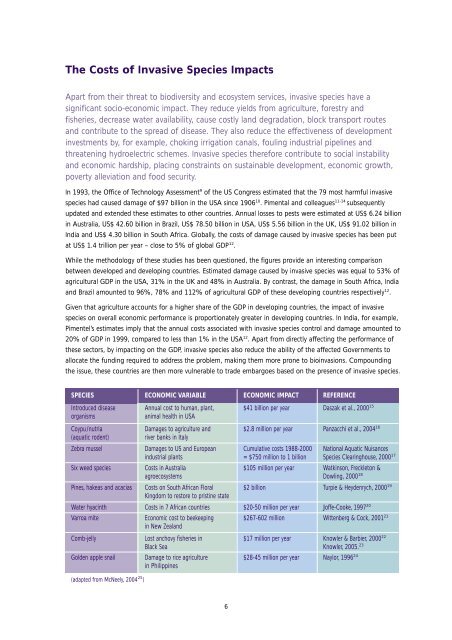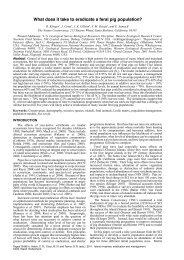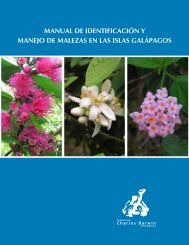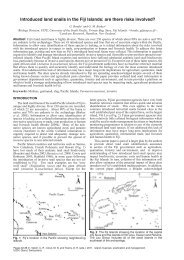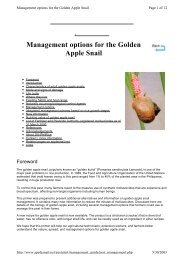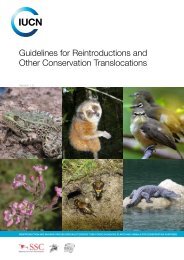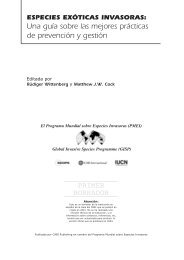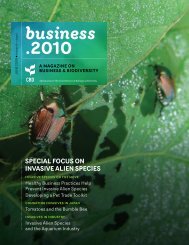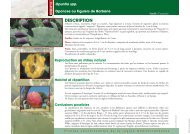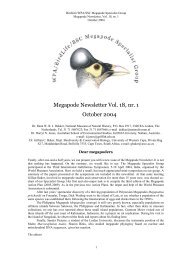English - IUCN Invasive Species Specialist Group
English - IUCN Invasive Species Specialist Group
English - IUCN Invasive Species Specialist Group
You also want an ePaper? Increase the reach of your titles
YUMPU automatically turns print PDFs into web optimized ePapers that Google loves.
The Costs of <strong>Invasive</strong> <strong>Species</strong> Impacts<br />
Apart from their threat to biodiversity and ecosystem services, invasive species have a<br />
significant socio-economic impact. They reduce yields from agriculture, forestry and<br />
fisheries, decrease water availability, cause costly land degradation, block transport routes<br />
and contribute to the spread of disease. They also reduce the effectiveness of development<br />
investments by, for example, choking irrigation canals, fouling industrial pipelines and<br />
threatening hydroelectric schemes. <strong>Invasive</strong> species therefore contribute to social instability<br />
and economic hardship, placing constraints on sustainable development, economic growth,<br />
poverty alleviation and food security.<br />
In 1993, the Office of Technology Assessment 9 of the US Congress estimated that the 79 most harmful invasive<br />
species had caused damage of $97 billion in the USA since 1906 10 . Pimental and colleagues 11-14 subsequently<br />
updated and extended these estimates to other countries. Annual losses to pests were estimated at US$ 6.24 billion<br />
in Australia, US$ 42.60 billion in Brazil, US$ 78.50 billion in USA, US$ 5.56 billion in the UK, US$ 91.02 billion in<br />
India and US$ 4.30 billion in South Africa. Globally, the costs of damage caused by invasive species has been put<br />
at US$ 1.4 trillion per year – close to 5% of global GDP 12 .<br />
While the methodology of these studies has been questioned, the figures provide an interesting comparison<br />
between developed and developing countries. Estimated damage caused by invasive species was equal to 53% of<br />
agricultural GDP in the USA, 31% in the UK and 48% in Australia. By contrast, the damage in South Africa, India<br />
and Brazil amounted to 96%, 78% and 112% of agricultural GDP of these developing countries respectively 12 .<br />
Given that agriculture accounts for a higher share of the GDP in developing countries, the impact of invasive<br />
species on overall economic performance is proportionately greater in developing countries. In India, for example,<br />
Pimentel’s estimates imply that the annual costs associated with invasive species control and damage amounted to<br />
20% of GDP in 1999, compared to less than 1% in the USA 12 . Apart from directly affecting the performance of<br />
these sectors, by impacting on the GDP, invasive species also reduce the ability of the affected Governments to<br />
allocate the funding required to address the problem, making them more prone to bioinvasions. Compounding<br />
the issue, these countries are then more vulnerable to trade embargoes based on the presence of invasive species.<br />
SPECIES ECONOMIC VARIABLE ECONOMIC IMPACT REFERENCE<br />
Introduced disease Annual cost to human, plant, $41 billion per year Daszak et al., 2000 15<br />
organisms<br />
animal health in USA<br />
Coypu/nutria Damages to agriculture and $2.8 million per year Panzacchi et al., 2004 16<br />
(aquatic rodent)<br />
river banks in Italy<br />
Zebra mussel Damages to US and European Cumulative costs 1988-2000 National Aquatic Nuisances<br />
industrial plants = $750 million to 1 billion <strong>Species</strong> Clearinghouse, 2000 17<br />
Six weed species Costs in Australia $105 million per year Watkinson, Freckleton &<br />
agroecosystems Dowling, 2000 18<br />
Pines, hakeas and acacias Costs on South African Floral $2 billion Turpie & Heydenrych, 2000 19<br />
Kingdom to restore to pristine state<br />
Water hyacinth Costs in 7 African countries $20-50 million per year Joffe-Cooke, 1997 20<br />
Varroa mite Economic cost to beekeeping $267-602 million Wittenberg & Cock, 2001 21<br />
in New Zealand<br />
Comb-jelly Lost anchovy fisheries in $17 million per year Knowler & Barbier, 2000 22<br />
Black Sea Knowler, 2005. 23<br />
Golden apple snail Damage to rice agriculture $28-45 million per year Naylor, 1996 24<br />
in Philippines<br />
(adapted from McNeely, 2004 25 )<br />
6


